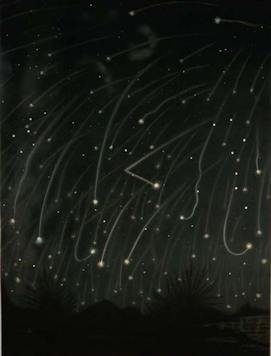And generally a meteor shower isn't a spectacular showering of lights. It is a sparse thing that happens only occasionally. Some showers will give maybe 5-10 meteors per hour. And the most reliable shower will sometimes peak at around 100-120 per hour. And these numbers vary a lot. These numbers are based on what we have observed in previous years.
Typically a meteor will look something like this. It is very fast and short lived streak across the sky. The large majority of these are faint and you need a dark sky to see them. Occasionally one will be bright and even dramatic. I have seen a bright one even during the day, they can be that spectacular.


And occasionally they can be quite spectacular like this Leonid meteor shower that occurred in 1868. It is estimated to have a rate of 1000 per hour.
This is an artist's rendition by Étienne Léopold Trouvelot
How to watch a meteor shower
1. The first thing you should do is check the weather. If the sky is overcast or cloudy you are not going to see any meteors. You need a clear night or at least a night with very few clouds.
2. Meteor streaks are typically very dim so you need a good dark sky. This means you should seek out a location away from city lights if possible. And this also means that a full moon can interefere a lot with your ability to see the streaks.
3. A telescope is of no use for watching a meteor shower. This is something to be viewed with the naked eye. This is because it randomly occurs over a large portion of the sky.
4. To observe a shower you should stay warm and make yourself comfortable. I like to recline on a beach chair so I can comfortably look up at the sky without craning my neck for long periods of time.
5. Get some kind of a star chart! And make note of what constellation the meteor shower originates from. This way you can turn your beach chair in the right direction. If you can't figure out a star chart you can just patiently observe the whole sky. Once you have seen a few of them you will know the general area to watch.
Note: Meteor showers can last for around 6-10 nights but definitely have a peak night or two. I give you this information when applicable. I also list any full moons around the date of a meteor shower.
So.. Here are the upcoming Meteor showers for 2016
Jan 3-4 Quadrantids up to 40 an hour -Constellation of Bootes - Look to the Northeast near the big dipper
April 22-23 Lyrid Meteor shower – up to 20 an hour - Look to the Northeast near the constellation of Lyra which has a very bright star called Vega
May 6-7 Eta Aquarids up to 30 an hour - This is a very spread out meteor shower in terms of when it happens. It doesn't really peak but for a week around May 6-7 it is generally at its best. Look to the constellation of Aquarius
July 28 - 29 Delta Aquarids – up to 20 an hour - Another meteor shower spread out in time, generally the best rates are around July 28-29 Look to the constellation Aquarius
August 12-13 Perseids up to 60 an hour - This can be a very prolific meteor shower - look to the constellation of Perseus which will be in the northern sky
Oct 7 Draconids meteor shower – up to 10 an hour - This is typically a weak meteor shower but because it is the remnants of a comet the Earth will occasionally pass right through the path of the comet and the meteor rate can spike into the hundreds per hour. Look to the Northern sky in the constellation of Draco.
Oct 21-22 Orionids up to 20 per hour - This meteor shower can on some years peak to 60-70 per hour. It is associated with Halley's comet and look to the constellation of Orion to find it.
Nov 4-5 Taurids meteor shower 5-10 an hour - This is a shower of spread out and slow meteors. Often called the Halloween Fireball shower. Look to the constellation of Taurus.
Nov 17-18 Leonids meteor shower – up to 15 an hour - Look to the constellation of Leo
Dec 13 -14 Geminids – up to 120 an hour (dec 7-17 with peak around 13th. - Look to the constellation of Gemini. It is thought that this meteor shower is growing in intensity each year.
Dec 21 22 Ursids – 5-10 an hour - This is another spread out meteor shower that usually peakes around the dec 21-22. Look to the little dipper in the north sky, not far from the north star.

Do you like making projects and exploring a variety of hobbies?
Sign up for my free newsletter. I give you regular updates on hobbies and projects you can make. it is totally free and I don't share your email with anybody.
|
![]()







